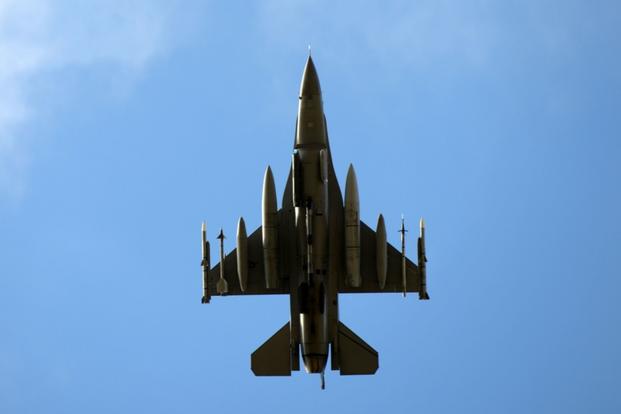An Air Force civilian employee was in charge of assembling the engine part blamed for the crash of an F-16 Fighting Falcon near Washington, D.C., last April.
The former employee, then with the 552nd Commodities Maintenance Squadron, incorrectly assembled the main engine control, a main factor in the crash, Air Force Material Command recently told Military.com.
A report found that the part in question had failed inspection twice before the accident.
Military.com requested additional information on the April 5, 2017, accident, which occurred at 9:17 a.m. local time several miles southwest of Joint Base Andrews, Maryland, in a wooded area in the town of Clinton.
While the pilot safely ejected and wasn't injured, the $22 million single-engine fighter was destroyed.
Related content:
- Missing Engine Parts Caused F-16 Crash Near DC, Air Force Says
- USAF Short About 200 Maintainers, Pilot Training Continues: SecAF
- Air Force Turns to Civilians to Give Squadrons Much-Needed Relief
"The Accident Investigation Board determined that the incorrect assembly of the component (main engine control) was to blame, with a substantial contributing factor being the lack of an adequate procedural requirement for parts accountability," said Air Force Material Command spokesman Derek Kaufman.
Elaborating on the report, released Oct. 26, he said the Air Force determined that "existing maintenance processes and technical data were not followed, resulting in an internal components failure during operation."
"The engine component (main engine control) was overhauled and returned by the [Oklahoma City Air Logistics Complex] to the supply system. An Air Force civilian employee from the 552nd Commodities Maintenance Squadron performed the maintenance on the failed component," Kaufman said in a recent email statement.
Noting the individual was not a contractor, Kaufman said the employee is "no longer in government service." He did not say whether the civilian's end of employment was a result of the mishap.
The 552nd Commodities Maintenance Squadron is a Materiel Command unit under the Oklahoma City Air Logistics Complex at Tinker Air Force Base.
"A preponderance of evidence showed that the main engine control was missing a required 600-degree retaining ring and the anti-rotation pin," ACC said at the time of the investigation report.
"The misassembled differential pressure pilot valve caused the main engine control to incorrectly meter abnormally high fuel flow to the engine. This led to severe engine overspeed, severe engine over-temperature, engine fire and, ultimately, a catastrophic engine failure," the release said.
After overhaul, the main engine control "underwent routine operational testing on 31 January 2017, and failed to meet performance standards," the report said. "After failure of its first operational test, the [mishap aircraft] MEC was inspected and found to have a fuel cam spline misaligned. The error was corrected and MA MEC was re-tested on 16 February 2017."
But during the second operational test, the engine control once again failed to meet performance standards. Maintenance crew from the 552nd noted problems with the fan discharge temperature, spring and variable stator vane, which regulate pressure, compression and performance within the engine.
The engine control was tested again on March 8 and passed inspection.
It then went to the 113th Maintenance Squadron (MXS) Engine Shop at Joint Base Andrews and was installed on engine S/N 509307, passing an operational engine run test on April 4.
The next day, shortly after takeoff, the plane experienced engine acceleration followed by a loss of thrust.
"Personnel involved with the [mishap aircraft's] preparation for the flight had adequate training,
experience, and expertise to perform their assigned tasks," the report said. "There is no evidence to suggest that 113th AMXS maintenance personnel and supervision were a factor in this mishap."
In recent years, the Air Force had struggled to fill gaps within its maintainer ranks.
In 2016, the service said it was roughly 4,000 maintainers short. It quickly began to prioritize staffing for air combat units with higher operations tempo, reshuffling more experienced maintainers throughout the force, with an emphasis on combat-coded units.
Just 21 months later, the service says it's doing "much better" on recruiting and retaining new maintenance airmen, Air Force Secretary Heather Wilson told reporters during a briefing in February.
"We've now got enough people, [now it's about] getting them experience," she said.
-- Editor's Note: This story has been updated to reflect the correct command structure for the 552nd Commodities Maintenance Squadron. It falls under the Oklahoma City Air Logistics Complex at Tinker Air Force Base.
-- Oriana Pawlyk can be reached at oriana.pawlyk@military.com. Follow her on Twitter at @Oriana0214.










